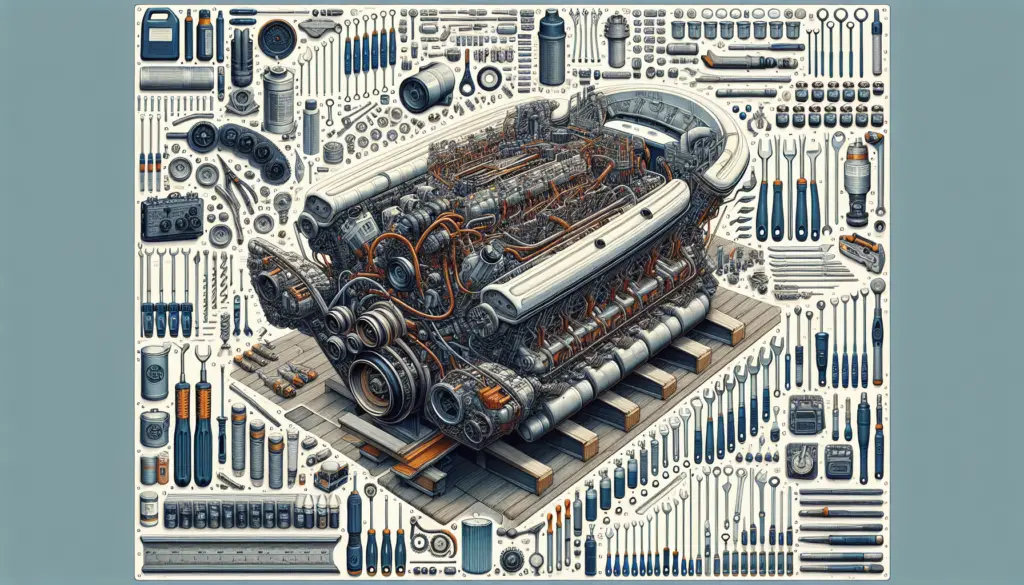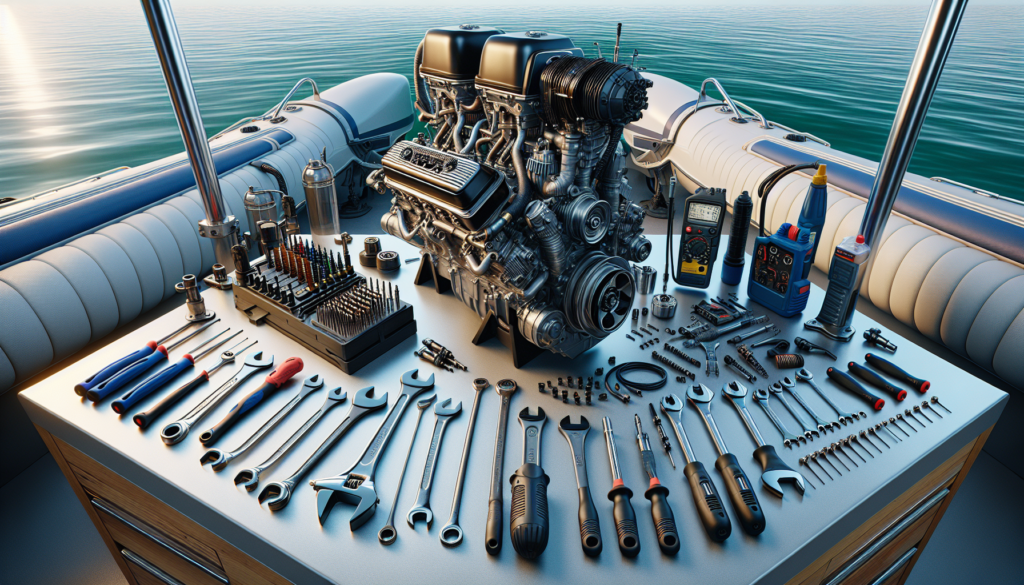Getting ready for a major voyage? Ensuring that all systems are ‘go’ could mean the difference between a memorable adventure and a sea tale of woe. In “The Ultimate Checklist For Servicing Your Boat Engine Before A Big Trip”, you will discover well-detailed steps to help you secure your boat engine and get it prepped for your journey. From the oil to the ignition system, every nook and cranny of your boat engine is covered in this practical guide. It’s more than just an article; it’s your companion towards a hassle-free boating experience.
Understanding the type of your boat engine
Before you begin maintaining your boat engine, it’s crucial to familiarize yourself with the type of engine your boat uses. In general, there are two key types: outboard and inboard engines. Outboard engines are primarily used in smaller boats and are known for their minimalistic design, and its all-in-one functionality, meaning the engine, gearbox, and drive are all integrated into one compact system that’s mounted to the rear of the boat. On the other hand, inboard engines, typically found in larger vessels, sit inside the boat, driving a propeller shaft that runs through the hull and are known for their increased horsepower and stability on larger bodies of water.
Types of boat engines
While outboard and inboard engines are the main classifications, there are also further differentiations including gasoline, diesel, and even electric engines. Each of these engine types have their own specifications, advantages, and maintenance needs, which must be taken into consideration when servicing your boat engine.
Specific maintenance for each type
Gasoline engines tend to require more frequent maintenance as their parts wear faster. Diesel engines, while generally requiring more upfront investment, often have longer service intervals. Electric engines, similar to those found in cars, need regular battery inspections and coolant checks. No matter the type, servicing the engine regularly helps prolong its life and keeps you offshore longer.
Inspecting the boat engine for potential problems
Engine inspection is one of the first things you need to do to ensure your boat engine’s smooth cruises. A thorough examination can detect potential problems that might lead to bigger and more expensive complications.
Checking for visible damages
From belt cracks to rust and corrosion, visual inspection should always be the first step. Look for anything unusual and if you spot anything amiss such as warped belts, oil leaks or discolouration around the engine, these should be addressed immediately.
Checking for unusual sounds
Engine noises can be an indicator of problems. Listen for abnormal sounds, such as knocking, grinding or whining, these could point to issues like mechanical failure, low lubrication levels or problems with the bearings.
Finding leaks
Leaks can lead to severe damage if left unaddressed. Regularly check oil, fuel and coolant levels in your engine and if there’s any significant decrease, a leak may be present and need immediate attention.
Checking engine mount
Engine mounts need to be checked for any wear and tear, and also tightness. Loose mounts can lead to misaligned propulsion systems and cause unnecessary vibrations, which can be harmful for the engine.
Assessing engine alignment
Misaligned engines can lead to strain on the shaft and seals, leading to premature wear and potential failure. Make sure to maintain proper alignment between your engine and shaft to ensure smooth operation.

Changing the engine oil and filter
Changing the engine oil and filter is crucial for your boat’s performance. This is akin to the regular oil change you would perform on your car.
Reasons for regular oil change
Oil change is the heart of your engine maintenance. It lubricates, cools and cleans the engine. But over time, oil becomes dirty and its lubricating qualities diminish, causing more wear to the engine.
How to change engine oil and filter
To change your oil, make sure the engine is warm and then, using an oil extractor, remove all the old oil. Swap the old filter for a new one before pouring in the fresh oil. Always make sure to consult your boat’s manual for specifications on the type and quantity of oil required.
Choosing the right oil and filter
It’s vital to use the right type of oil and filter for your engine. The wrong type can damage the engine and reduce its lifespan. Consult your owner’s manual or your local dealer to make sure you’re selecting the correct type.
Inspecting the cooling system
The cooling system serves to keep your engine from overheating, which could lead to potential damage. Maintenance of the cooling system is thus, a significant part of the overall engine upkeep.
Understanding the importance of cooling system
Boat engines generate a lot of heat and without a properly functioning cooling system, this heat can cause serious damage. The cooling system works by circulating coolant around the engine, keeping it at a safe operating temperature.
How to maintain good condition of cooling system
Regularly inspect the condition of the cooling system, look for any leaks, check the coolant level, and ensure that the pump is working correctly. Don’t overlook inspecting the impeller, hoses, and clamps as well.
Dealing with coolant leaks
Coolant leaks can lead to engine overheating, so it’s crucial to identify and fix them quickly. If you spot any coolant pooling under your engine, or notice a significant drop in the coolant level, you may have a leak.
Changing the coolant fluid
Coolant fluid should be changed as per the manufacturer’s recommendations. Typically, this involves draining the old coolant, flushing the system with clean water, and then filling it with fresh coolant.

Checking and maintaining the fuel system
Keeping the fuel system in good condition is key to maintaining the performance of your boat engine.
Importance of clean fuel for your boat engine
Dirty or contaminated fuel can cause a bunch of problems with your engine, from reduced performance to causing harmful clogs in the fuel system. Therefore, ensuring the fuel is consistently clean and free of contaminants is a vital part of engine maintenance.
How to clean the fuel tank
Cleaning your fuel tank thoroughly and regularly can help prevent many potential problems. This typically involves pumping out the old fuel, cleaning the interior of the tank, and then refilling it with fresh, clean fuel.
Checking for deteriorated or damaged fuel lines
Over time, fuel lines can become damaged or corroded. Regularly inspect the fuel lines for any signs of wear and tear and replace them if needed.
Choosing fuel additives
Fuel additives can help keep your engine running smoothly. They not only help clean the fuel system but also improve the boat’s overall performance. Make sure you choose the right fuel additives for your engine type.
Inspecting and changing spark plugs
Spark plugs play a crucial role in your boat’s engine by igniting the fuel-air mixture that drives the engine.
Understanding the role of spark plugs
Spark plugs are small but vital. They generate a spark of electricity that ignites the air and fuel mixture in the engine. If your spark plugs aren’t functioning correctly, your boat’s performance can be significantly reduced.
When and how to clean or replace spark plugs
Over time, spark plugs can become dirty or worn out. It’s good practice to clean and adjust the gap in your plugs at least every 100 hours of operation, and to replace them annually or at every 1000 hours of operation.

Inspecting and cleaning the carburetor
The carburetor is an essential component of your boat’s engine that blends air with fuel for combustion. It needs regular check-ups to perform effectively.
Understanding the role of the carburetor
The carburetor is responsible for providing the right fuel mixture for different engine speeds. A malfunctioning or dirty carburetor can result in reduced engine performance or uneven idling.
Indicators of a dirty carburetor
Signs of a dirty carburetor include difficulty in starting your boat engine, poor fuel economy, or engine flooding or overheating. If you’re observing these signs, a thorough carburetor cleaning might be in order.
Cleaning the carburetor
Generally, you should clean your carburetor every year or every 100 hours of operation, depending on which occurs first. Do this by disassembling the carburetor, then cleaning each part with a carburetor cleaner before reassembling.
Ensuring the battery is in good working condition
A boat’s engine, regardless of its type, relies heavily on the battery. Therefore, regular checks and maintenance are necessary to keep it in good shape.
When to replace the boat engine’s battery
The lifespan of a boat engine’s battery depends on several factors, including usage, maintenance, and the quality of the battery. Typically, batteries should be replaced every three to five years.
How to check the battery’s health
An easy way to check the battery’s health is by using a multimeter. This device can measure the battery voltage and give you a sense of whether it’s maintaining charge or needs replacement. Also regularly inspect for signs of physical damage or corrosion around terminals.
Maintaining the battery
Proper maintenance of the battery includes cleaning the terminals, ensuring battery cables are tight, and making sure the battery is secure in its mount. It’s also essential to keep the battery charged, especially in the off-season as batteries naturally deplete over time.

Checking the belts and hoses
Belts and hoses play a vital role in the operation of your boat engine. They power various components of your engine and transmit fluids, making their inspection and maintenance crucial.
Identifying worn out or loose belts and hoses
Belts and hoses can degrade over time due to wear and tear, heat, and engine vibrations. Regularly inspect them, looking for cracks, splits, or brittle areas. Also, ensure they are tight and well fitted as loose belts can hinder the operation of the parts they are driving.
How to replace or adjust belts and hoses
Replacing worn belts and hoses is typically straightforward. For belts, the process usually involves loosening the tensioner, removing the old belt, then placing the new belt. Hoses normally require you to loosen the clamps, remove the old hose and then replace it.
Final pre-trip preparations
Before leaving the dock, it’s important to perform one last check on the boat engine and keep an emergency repair kit on your boat in case of breakdowns.
Testing the boat engine
Before setting off on a big trip, run your engine at dock to make sure it’s performing properly. Look for any potential issues such as an unusual noise, smoke, or vibrations that might indicate a problem.
Final inspection on all boat systems
Give your entire boat a once-over. Check the fuel and fluid levels, test the boat’s lights and electronics, and take a long, hard look at your safety equipment. Make sure everything is functional and in place.
Keeping an emergency repair kit
No matter how well you’ve serviced your boat engine, having an emergency repair kit is essential. It should contain critical spare parts like extra fuel filters, drive belts, spark plugs, fuses, and some basic tools to ensure you can handle minor issues during your trip.
In conclusion, consistent engine care is paramount for ensuring your boat stays reliable and runs at peak performance for many memorable trips ahead. Always consult your engine’s manual and consider seeking professional help for tasks that are beyond your skill level.


